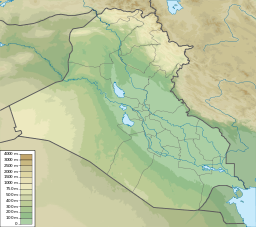
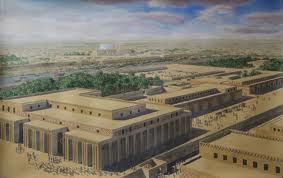
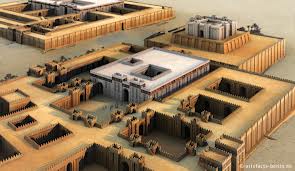
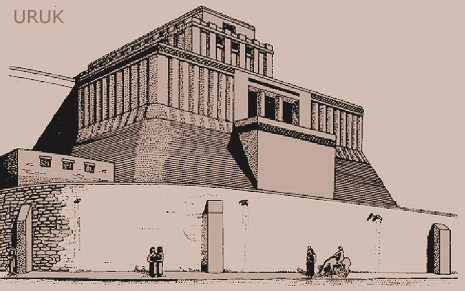
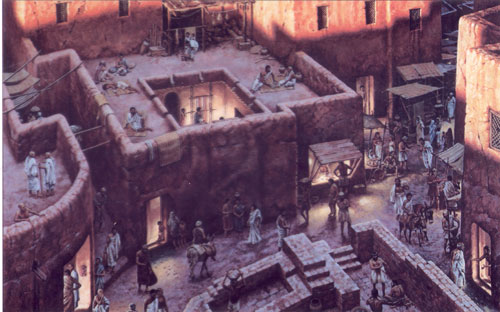
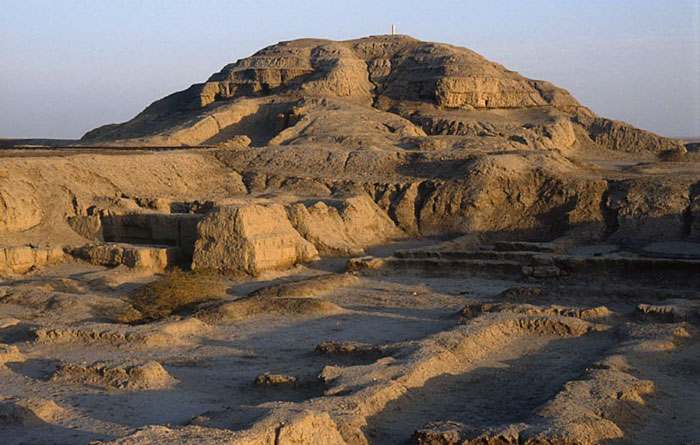
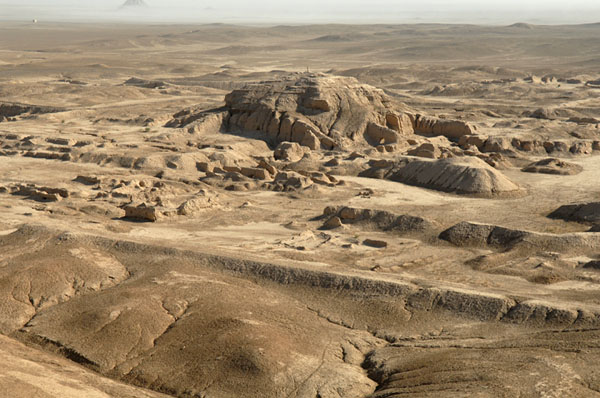
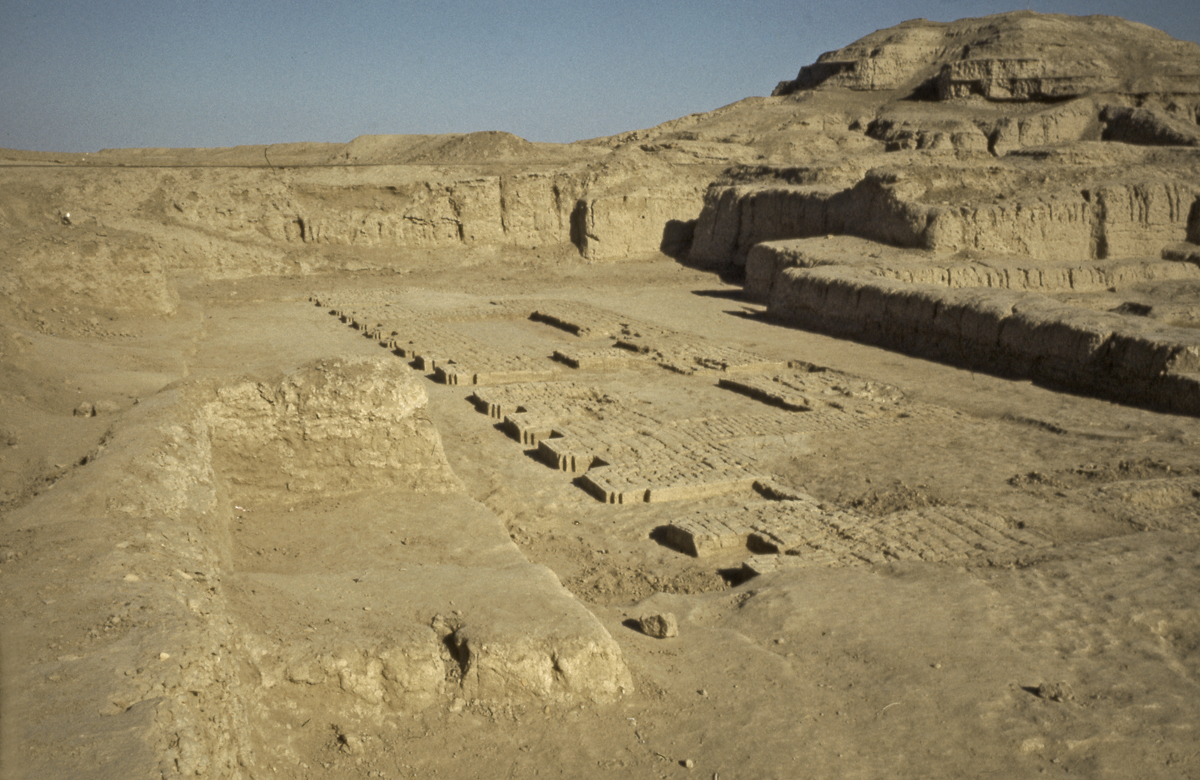
Text source: Wikipedia
Uruk-Warka
Uruk (Cuneiform: ,URU UNUG; Sumerian: Unug; Akkadian: Uruk; Aramaic: Erech; Hebrew: Erech; was an ancient city of Sumer and later Babylonia, situated east of the present bed of the Euphrates river, on the ancient dry former channel of the Euphrates River, some 30 km east of modern As-Samawah, Al-MuthannÄ, Iraq.[1].
Uruk gave its name to the Uruk period, the protohistoric Chalcolithic to Early Bronze Age period in the history of Mesopotamia spanning c. 4000 to 3100 BC, succeeded by the Jemdet Nasr period of Sumer proper. Uruk played a leading role in the early urbanization of Sumer in the mid 4th millennium BC. At its height c 2900 BC, Uruk probably had 50,000–80,000 residents living in 6 km2 of walled area; making it the largest city in the world at the time.[1] The semi-mythical king Gilgamesh, according to the chronology presented in the Sumerian king list, ruled Uruk in the 27th century BC. The city lost its prime importance around 2000 BC, in the context of the struggle of Babylonia with Elam, but it remained inhabited throughout the Seleucid and Parthianperiods until it was finally abandoned shortly before or after the Islamic conquest.
The site of Uruk was discovered in 1849 by William Kennett Loftus who led the first excavations from 1850 to 1854. The Arabic name of Babylonia, al-Ê¿IrÄq, is thought to be derived from the name Uruk, via Aramaic (Erech) and possibly Middle Persian (ErÄq) transmission.[2]
Prominence
In myth and literature, Uruk was famous as the capital city of Gilgamesh, hero of the Epic of Gilgamesh. It is also believed Uruk is the biblical (Genesis 10:10) Erech, the second city founded by Nimrod in Shinar.
In addition to being one of the first cities, Uruk was the main force of urbanization during the Uruk period (4000–3200 BC). This period of 800 years saw a shift from small, agricultural villages to a larger urban center with a full-time bureaucracy, military, and stratified society. Although other settlements coexisted with Uruk, they were generally about 10 hectares while Uruk was significantly larger and more complex. The Uruk period culture exported by Sumerian traders and colonists had an effect on all surrounding peoples, who gradually evolved their own comparable, competing economies and cultures. Ultimately, Uruk could not maintain long-distance control over colonies such as Tell Brak by military force.
Geographic factors underpin Uruk's unprecedented growth. The city was located in the southern part of Mesopotamia, an ancient site of civilization, on the Euphrates rivers. Through the gradual and eventual domestication of native grains from theZagros foothills and extensive irrigation techniques, the area supported a vast variety of edible vegetation. This domestication of grain and its proximity to rivers enabled Uruk's growth into the largest Sumerian settlement, in both population and area, with relative ease.[3]
Uruk's agricultural surplus and large population base facilitated processes such as trade, specialization of crafts and the evolution of writing. Evidence from excavations such as extensive pottery and the earliest known tablets of writing support these events. Excavation of Uruk is highly complex because older buildings were recycled into newer ones, thus blurring the layers of different historic periods. The topmost layer most likely originated in the Jemdet Nasr period (3100–2900 BC) and is built on structures from earlier periods date back to the Ubaid period.
History
Uruk In myth, Uruk was founded by Enmerkar, who brought the official kingship with him, according to the Sumerian king list. He also, in the epic Enmerkar and the Lord of Aratta, constructs theHouse of Heaven (Sumerian: e2-anna; Cuneiform: ð’‚ð’€ E2.AN) for the goddess Inanna in the Eanna District of Uruk. In the Epic of Gilgamesh, Gilgamesh builds the city wall around Uruk and is king of the city.
Uruk went through several phases of growth, from the Early Uruk period (4000–3500 BC) to the Late Uruk period (3500–3100 BC).[1] The city was formed when two smaller Ubaid settlements merged. The temple complexes at their cores became the Eanna District and the Anu District dedicated to Inanna and Anu, respectively.[1] The Anu District was originally called 'Kullaba' (Kulab or Unug-Kulaba) prior to merging with the Eanna District. Kullaba dates to the Eridu period when it was one of the oldest and most important cities of Sumer. There are different interpretations about the purposes of the temples. However, it is generally believed they were a unifying feature of the city. It also seems clear that temples served both an important religious function and state function. The surviving temple archive of the Neo-Babylonian period documents the social function of the temple as a redistribution center.
The Eanna District was composed of several buildings with spaces for workshops, and it was walled off from the city. By contrast, the Anu District was built on a terrace with a temple at the top. It is clear Eanna was dedicated to Inanna from the earliest Uruk period throughout the history of the city.[4] The rest of the city was composed of typical courtyard houses, grouped by profession of the occupants, in districts around Eanna and Anu. Uruk was extremely well penetrated by a canal system that has been described as, "Venice in the desert."[5] This canal system flowed throughout the city connecting it with the maritime trade on the ancient Euphrates River as well as the surrounding agricultural belt. It should be noted the original city of Uruk was sited southwest of the ancient Euphrates River, now dry. Currently, the site of Warka is northeast of the modern Euphrates river. The change in position was caused by a shift in the Euphrates at some point in history, and may have contributed to the decline of Uruk.
Historic periods of Uruk
Archeologists have discovered multiple cities of Uruk built atop each other in chronological order.[6]
Uruk XVIII Eridu period (c 5000 BC); the founding of Uruk
Uruk XVIII-XVI Late Ubaid period (4800–4200 BC)
Uruk XVI-X Early Uruk period (4000–3800 BC)
Uruk IX-VI Middle Uruk period (3800–3400 BC)
Uruk V-IV Late Uruk period (3400–3100 BC); The earliest monumental temples of Eanna District are built.
Uruk III Jemdet Nasr period (3100–2900 BC); The 9 km city wall is built
Uruk II
Uruk I
Text source: Wikipedia
You are welocome to send your comments and proposals as well any useful photos, documents, links for website update using our following address:
الصفحة ترحب باية ملاحظات او مقترحات كما تتطلع لاستلام اية صور او وثائق او روابط مفيدة لتحديثها عبر المراسلة على العنوان الالكتروني التالي
info@uruk-warka.dk
Special update on URUK and Exhibition in Pergamon Museum ... تحديث خاص عن اوروك والمعرض في متحف بيرجامون
URUK in Pergamon Musem Berlin 2013 Link 1 - اوروك في متحف بيرجامون 2013
Images of URUK in Pergamon Museum Link 2 - صور عن اوروك في متحف بيرجامون
URUK in Pergamon Musem Berlin 2013 Link 3 - اوروك في متحف بيرجامون 2013
URUK in Pergamon Musem Berlin 2013 Link 4 - اوروك في متحف بيرجامون 2013
URUK in Pergamon Musem Berlin 2013 Link 5 - اوروك في متحف بيرجامون 2013
Press release ... اخبار الصحافة
Statements in Germany ... التصريحات بالالمانية
Statements in English ... التصريحات بالانجليزية
Uruk Exhibition ... معرض اوروك
URUK - WARKA ... اوروك - الوركاء
Uruk- 5000 Years of the Megacity ... اوروك 5000 عام من المدينة الواسعة
Uruk- 5000 Years of the Megacity 2 ... اوروك 5000 عام من المدينة الواسعة
URUK - 5000 Years of the Megacity ... اوروك 5000 عام على المدينة الواسعة
Uruk ... أوروك
URUK PLAN ... خريطة اوروك
URUK Photo ... صور من اوروك
Other updates ... تحديثات اخرى
Uruk Photos - صور من اوروك
CITY-STATES OF ANCIENT - SUMER ... دول المدن في سومر
Uruk 07/07/2013 .... اوروك تقرير 07-07-2013